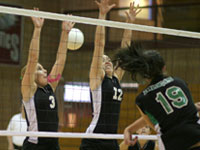Volleyball is a fast-paced game played on a fairly small court surface. There are six players per side on a court that is only 30 feet by 30 feet and 900 square feet to defend. To the outsider that may seem like a lot of area to cover, but in reality the size of the court dictates that teams must have outstanding communication skills and chemistry in order to achieve success.
It is the responsibility of the coach to design effective drills that promote team chemistry, communication and reinforce or develop good fundamentals.
The drills described below can and should be adapted so they fit best with your team and situation.

Short Court Scramble – with Conditioning
This drill involves the entire team; in fact, the more players the better. We usually start by breaking the team into two groups. It can be random, starters vs. non-starters; however, it is works best for you. Have the participants get a partner, then have them stand with the net dividing them. We do a lot of partner work in practice so this is a usual thing for us to do in many of our drills. You should have at least six players on each side of the net. Don’t worry if you have an uneven number, such as 7 vs. 6, because the same goals apply.
The drill works as follows: The two teams are all inside the 10-foot line, sideline to sideline. The playing court boundaries are the normal sideline and 10-foot line. The coach puts a ball in play to either side. The entry of the ball is random choice by the coach – toss, tip, toss off the net – the more random the better.
Here’s where the fun starts – each and every time a player touches the ball he or she must run to the endline and touch the endline before returning to the “court” area inside the 10-foot line and play another ball. If a player has a second touch of the ball without first running the line, the team loses all its points.
The game is usually played to 11 points. If a ball hits the floor untouched by the defense, the team loses all its points. This drill should be run at a fast pace – players get lots of conditioning, and they must communicate to get teammates to run, play balls. It usually gets hectic pretty quickly. As soon as the ball in play hits the floor, the next ball should be entered into play. The more hectic and chaotic, the better the drill is, as it forces players to communicate quickly and effectively. The running is great for conditioning as its game-like with short quick bursts or sprints.
Around the World Passing
This is a very simple passing drill for 8-12 players that maximizes touches of the ball, with ball entry and passing target changing directions and angles. Players start in a line at left back. The coach is on the opposite side of the net at right back. One player is at the net as the target on player side. The coach enters ball to passer. Players rotate from passer to target to handing ball to coach then back to passing line. When initial target rotates around back to target position, the coach moves to the middle of the court to enter ball, with players continuing to move quickly from passer to target to hand ball to coach then back to passing line. After each player has passed one ball entered from middle back, coach rotates to left back.
After each player has passed one ball entered from right back, then middle back, then left back, the passing line moves to middle back and the coach enters balls from left back, then rotates to middle back then to right back. The passing line then shifts to right back and the coach rotates from right back to middle back then finishes at left back.
The coach controls ball entry – tosses, free balls, down balls or serve. Many times we go through the entire rotation first with free balls, then down balls, then serves. To keep players moving quickly and stay focused, we do this drill with only three balls, forcing players to sprint and stay focused. If I have to wait for a ball because of slow moving player or shanked pass not shagged quick enough, we usually have a consequence at the end of the drill.
A variation or addition to this drill is to give players a single focus that changed as the line moves from left back to middle back to right back. The focus is a key phrase. A few I use are:
“feet to the ball”
“freeze after contacting the ball”
“platform out early”
“keep the ball between your feet”
“face the ball tilt to target”
By changing the focus and giving feedback on only the one focus, players tend to show continuous improvement.
No Mistakes SR Game
Starting team (team A) begins on one side of the net in serve receive. Second team (team B) starts on the other side of the net serving. The game is played to 15 points or whatever number you decide is appropriate for your team/practice. Play regular volleyball with only team B serving and team A always on serve receive. The catch – teams only score on a positive play – an attack for a kill, an ace, a block that terminates the play. Mistakes or errors - hitting a ball into the net, hitting a ball out, missing a serve – are washes and count as nothing. I feel this drill frees players to take swings and not worry about errors. Team A rotates every time it earns a point. This is a great game to work on serve receive.
Ace to Replace
On one side of the net, set up a serve receive – two, three or four passers based on your system. Add a target, such as three extra antennae along with the midcourt line to make the target area. Everyone else has a ball and is a server. You can only score points by making a pass that the target catches above shoulders with both feet in the target box. The only way you get to move from server to passer is to serve an ace – hence ace to replace (the passer). Set a point or time total for winning. Server goes from serve to target unless they serve an ace and become the new passer. Miss your serve, shag the ball and get back on the serving line.
This drill works on both passing tough serves and serving tough.
A variation is to have your primary passers stay together on the receive side and play a “match” vs. the rest of the team.
7-0
This is a six-on-six. The drill is very simple. Two teams play a game to 7 points. The catch – if a ball hits the floor untouched, that team losses all their points. The ball can be entered however the coach sees fit – serve the ball, free ball, down ball, toss ball, throw ball into the net and play it out of the net, and attack – whatever works for you. The seven-point total is arbitrary; 5 seems to short and longer seems to reduce the intensity of each point. After doing this drill a few times try not counting touches off the block as a touch. If you have competitive athletes this drill will make your team play better defense and get that “all out for every ball” attitude that we all want from our teams.
Player feedback from multiple years is that this is their single all-time favorite drill.
Lou Panzella
Lou Panzella is currently a special education teacher in his 28th year working for the Antioch (California) Unified School District. He has coached women’s high school volleyball for 25 years and boys high school volleyball for 24 years. He is currently the boys volleyball coach at Deer Valley High School in Antioch and is about to enter his second year as women’s head coach at Los Medanos Junior College in Pittsburg, California.
Most Recent Articles
- nfhs news NFHS Learning Center Delivers 25 Millionth Course
- Track & Field/Cross Country article Effective Communication with Athletes and Coaches
- nfhs news Player Equipment Changes Highlight 2025 High School Football Rules Revisions
- Player Equipment Changes Highlight 2025 High School Football Rules Revisions
- nfhs news Judgment Call on Second Contact Eliminated in High School Volleyball





